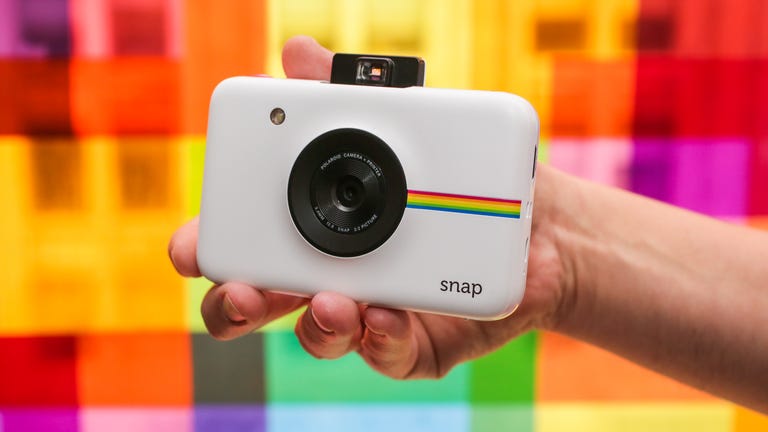 Why You Can Trust CNET
Why You Can Trust CNET Polaroid Snap Instant Digital Camera review: On-demand photo nostalgia for people who barely remember instant cameras
It's the most basic point-and-shoot digital camera and it's paired with a built-in mini photo printer -- and it's a lot of fun.
More than likely pictures from your smartphone will put those from the Polaroid Snap to shame. If that's your main concern -- a camera that's better than your phone -- stop reading and go here. The Snap just isn't about that.
The Good
The Bad
The Bottom Line
Priced at $100, £90, AU$200, the Snap is about having fun with your photography and being able to enjoy your pics -- not on a screen, but on a wall or notebook or anywhere you want to put an actual, 2x3-inch borderless print. It is, however, a 10-megapixel digital camera as well. That means you're getting a digital copy of your picture, too, to keep on your phone, to email to friends and family or to make a larger print.
What Polaroid -- or, more appropriately Polaroid licensee C&A Marketing -- has done is create a camera that's part-past, part-present, and small and light enough that you won't think twice about taking it along on your next adventure to a party or wedding, or just out into your backyard.
About as basic as a camera gets
One of the things I like most about the Snap is that it pretty much gets out of your way and just lets you shoot. There is no screen to frame your shot, but instead a small pop-up viewfinder on top that also turns the camera on. After a second or two it's ready to go and you can just press the shutter release and get your print. That's it.
On top at the far left there's a button that lets you change between normal, black and white, and vintage sepia tone color palettes. Next to that, there's a button that will add that classic Polaroid border to your print, and next to the shutter release there's a 10-second self-timer so you can get in your photo (a tripod mount is on the bottom). But those are all your shooting options and controls you have, there's no flash and it's a fixed focal length lens, which means you're zooming with your feet.
Let's get one urgently important item out of the way, however: Polaroid Snap requires an immediate firmware update to prevent it from accidentally printing pictures taken with the lens cap on. The firmware download and instructions are available on Polaroid's site. If you buy this product, make sure that's your first order of business.
The Snap is powered off a built-in rechargeable battery that's charged via a Micro-USB port on the side. A Micro-USB cable, magnetic lens cap and a wrist strap are included in the box. No paper is included, though, so you'll need to buy some before you can print your first shot.
Paper loads in the back of the camera and comes in packs of 10 sheets -- the most the camera can hold at one time. It uses Zink zero-ink paper embedded with cyan, yellow and magenta dye crystals. The crystals start off colorless, but as the print is being made, heat activates the crystals, changing them into the appropriate colors.
A pack of 30 sheets of Zink paper runs about $15, £15 or AU$33. The paper is the only consumable, so you don't have to worry about ink cartridges, and the prints come out dry and smudge-proof because there's no ink involved.
It prints every shot
The original Polaroid instant-film cameras as well as the Instax instant cameras from Fujifilm give you a print with each press of the shutter release. This is exactly how the Snap is made to work, too, so if there's paper in the camera and you take a picture, you're getting a print.
If you're fast and don't want a print for some reason, you can pop open the back, take out the paper and turn off the camera, and save yourself from a wasting a sheet. There is a microSDHC card slot on the side, so if you put a card in (cards up to 32GB are supported), you'll get a digital image, too. And you can use the camera without paper in it, though as I mentioned up top, the image quality isn't really the reason to buy this.
The tiny sticker-backed prints aren't the best quality. I mean, they're fine for what they are, but can't (nor are they intended to) compete with a traditional inkjet or dye-sub photo printer. I have some that are several years old and the colors haven't faded, but I wouldn't expect them to last forever.
Overall, though, the Snap is very good for what it is: an affordable pocket-sized instant-print camera. I wouldn't want it as my only camera, and it could easily fall into that category of gadgets you use a couple times and then stick in a drawer, especially if you don't keep a supply of paper on hand. But if you frequently find yourself wanting to decorate your home or office or belongings with pictures, it's worth the investment.
Also, if you like the idea of the Snap, but it sounds too limiting, Polaroid has the Snap+ on the way. That model will have a flash, touchscreen and built-in wireless that will allow you to print from the Snap+'s 13-megapixel camera or a smartphone or tablet. Pricing hasn't been announced yet, though, and it's not expected to be available until the end of 2016.


